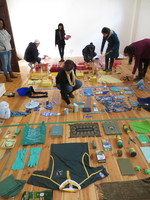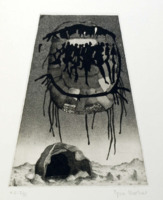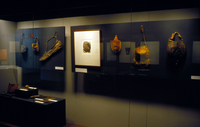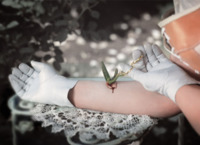Items
Site
The Medicine Chest
keywords is exactly
interdisciplinary
-

Playtone
Resulting from a 5-day taxonomy workshop which ran from 14 – 18 July 2014 as part of the Honours in Curatorship programme, the PLAYTONE exhibition depicts one of the various exercises students were asked to perform. Colours were allocated to groups, and students instructed to photograph all colour-coded objects during their daily routines, which were then classified using the PANTONE system. In addition to this, students also generated a selection of words they associated with their allocated colours and accumulated colour-coded personal belongings. Participants: Matthew Bradley, Annchen Bronkowski, Thea Ferreira, Sakhisizwe Gcina, Gail Gunston, Sharne McDonald, Mari McFarlane, Mosa Motaung, Thandiwe Msebenzi , Chloe Obermeyer, Bianca Packham, Lindelwa Pepu, Tazz Rossouw, Phenduliwe Sibisi -

Etching from 'Sound from the Thinking Strings'
"Skotnes’s own visual interpretation of the history and cosmology of the |xam formed the last component of this interdisciplinary endeavour and constituted a visual component that drew together the various strands of disciplinary interpretations and presented a perspective on the |xam life she felt ‘was missing from the other interpretations’ (Skotnes 1991: 30). In these images she drew freely on San mythology, accounts of |xam life recorded by Lucy Lloyd, historical and archaeological research and images from rock paintings in a landscape setting. She writes in her preface that these etchings were direct attempts at ‘inverting the museum dioramas’ in the ethnographic halls close to the exhibition and which, through their display of the San’s body casts, rendered them closer to specimens of biology than as members of a highly developed culture (Skotnes 1991: 52). By creating images that combined shamanistic rituals, entoptic spirals, plants, hunting bags, bows and arrows, snakes, eland-shaped rainclouds, colonists, musical instruments, shelters and therianthropic shapes, Skotnes eclipsed the static narratives of the dioramas and the object labels in the exhibition, placing them in a context in which their metaphysical qualities were celebrated more than their physical qualities. These prints stood in striking contrast to the other exhibits, which framed the San as physical types, and they challenged viewers to confront the reality that the San had a rich history and cultural and social life" (Liebenberg 2021: 157). -

Sound from the Thinking Strings (installation detail)
"Skotnes had a longstanding relationship with the museum, which started when she was still a student at the Michaelis School of Fine Art. Davison remembers that Skotnes would visit the taxidermy section of the South African museum to draw bones. As an anthropologist, Davison admits to finding Skotnes’s way of looking at things stimulating – an individual way of looking at objects that made her look at them differently, even though she was already very familiar with these materials. Davison recalls a visit to the ethnographic stores during which she showed Skotnes the San skin bags, carefully conserved in their drawers and laid out on acid-free paper. Skotnes admired not only their aesthetic qualities but related the stories she had been studying in the Bleek and Lloyd archive to them – stories that shifted their status from anthropological museum objects to powerful animate objects in San spiritual and social life (P. Davison, personal communication, 28 January 2021). Skotnes remembers that she asked staff whether they knew what was inside the bags and was shocked when nobody could remember looking in them. She was allowed to look inside one and found a claw, which they thought must be a leopard’s (P. Skotnes, personal communication, 9 May 2021)" (Liebenberg 2021: 2015). -

Resonance
"The revelation of my object-study that the chest was a lacuna in terms of local botanical medicinal remedies and practices served as inspiration for the first department I approached. By engaging with insiders of the Department of Biological Sciences, I reasoned that I could supplement the chest’s Western content with local botanical knowledge. As the first viewing session, it was also the one that initiated the weakening of the chest’s imperial viral load through an inoculation of additional meaning – a treatment with a surprising side-effect. On presenting the chest to other disciplinary insiders afterwards (to Pathology and the College of Music, for example), I noticed characteristics that also resonated with the field of botany within these disciplines and their collections. These botanical resonances accrued as my disciplinary engagements increased and diversified, leading me to embrace this side-effect and to use botany as the central theme of my exhibition. The resonances generated in the different departmental viewing sessions resulted in new links with the chest but also in connections surfacing between disciplines such as zoology, dermatology, pharmacology and sound studies, for example. I drew on these visits and their outcomes to create a range of artworks that materialised the inoculation of the chest by manifesting how intersecting with diverse fields expanded its meaning, and I sourced objects from the collections that encouraged new interpretations" (Liebenberg 2021: 244 - 246).


